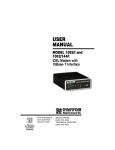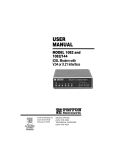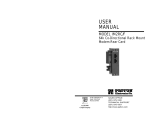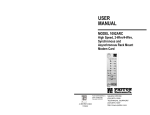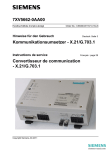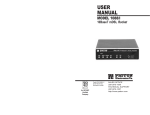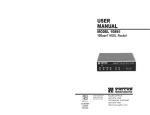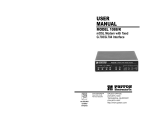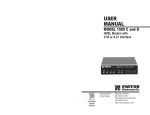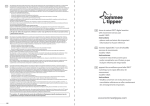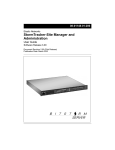Download Electrolux B6140-1 Microwave Oven User Manual
Transcript
USER MANUAL MODEL 1082/F iDSL Modem with G.703 Interface Part# 07M1082/F Doc# 033171UA Revised 10/8/02 CERTIFIED An ISO-9001 Certified Company SALES OFFICE (301) 975-1000 TECHNICAL SUPPORT (301) 975-1007 TABLE OF CONTENTS 1.0 1.1 1.2 1.3 Warranty Information ................................................................. FCC Information ........................................................................... CE Notice...................................................................................... Service.......................................................................................... 2.0 2.1 2.2 2.3 General Information.................................................................... 6 Features........................................................................................ 6 Description.................................................................................... 6 1082 SNMP Management Solutions............................................. 7 HTTP/HTML Management ........................................................... 7 System Description....................................................................... 7 Applications and Associated Timing............................................. 8 Timing of Application 1: Network Loop Extension ................. 8 Timing of Application 2: Network Replacement ..................... 9 Timing Mode Selections ............................................................. 10 Operating MODE SELECTIONS ................................................ 11 2.4 2.5 2.6 4 4 4 5 3.0 3.1 Configuration ............................................................................ 12 Configuring the Hardware DIP Switches .................................... 12 Configuring DIP Switch S1 ......................................................... 13 SW1-1 Octet Function ........................................................ 14 SW1-2 Hardware/Software ................................................. 14 SW1-3 Front Panel Switch Function .................................. 14 SW1-4 SNMP Control ........................................................ 14 SW1-5 Reserved ................................................................. 14 SW1-6/7 Clock Mode .......................................................... 15 SW1-8 RDL Function ......................................................... 15 4.0 4.1 4.2 Installation................................................................................. Connecting the Twisted Pair Interface........................................ Connecting Power ...................................................................... Universal AC Power (100–240 VAC).......................................... DC Power ................................................................................... 16 16 18 18 18 5.0 5.1 5.2 5.3 Operation................................................................................... Power-up .................................................................................... LED Status Monitors................................................................... Test Modes ................................................................................. Local Line Loopback (LLB)......................................................... Remote Digital Loopback (RDL)................................................. Using the V.52 (BER) test pattern generator.............................. 20 20 20 21 21 22 23 A A.1 A.2 A.3 A.4 A.5 Model 1082 specifications ....................................................... 24 Applications ................................................................................ 24 Transmission Format ................................................................... 24 Transmission Line ....................................................................... 24 Clocking ...................................................................................... 24 DSL Distance .............................................................................. 24 2 A.6 A.7 A.8 A.9 A.10 A.11 A.12 A.13 A.14 A.15 A.16 A.17 A.18 A.19 A.20 A.21 A.22 A.23 A.24 G.703 Distance ........................................................................... 24 A.7 Connector ............................................................................. 24 Operating Modes/speed ............................................................. 24 Line Coding ................................................................................ 24 Timing Modes ............................................................................. 25 TRANSMIT LEVEL ....................................................................... 25 Load Impedance ........................................................................ 25 Input Signal Level ....................................................................... 25 Jitter Performance ....................................................................... 25 Isoloation ..................................................................................... 25 Compliance ................................................................................. 25 LED Status Indicators ................................................................. 25 Power .......................................................................................... 25 Temperature Range .................................................................... 25 Altitude ........................................................................................ 26 Humidity ...................................................................................... 26 Dimensions ................................................................................. 26 Weight ......................................................................................... 26 Line Interface .............................................................................. 26 B Model 1082 Factory Replacement Parts and Accessories ... 27 3 1.0 WARRANTY INFORMATION Patton Electronics warrants all Model 1082/F components to be free from defects, and will—at our option—repair or replace the product should it fail within one year from the first date of shipment. This warranty is limited to defects in workmanship or materials, and does not cover customer damage, abuse or unauthorized modification. If this product fails or does not perform as warranted, your sole recourse shall be repair or replacement as described above. Under no condition shall Patton Electronics be liable for any damages incurred by the use of this product. These damages include, but are not limited to, the following: lost profits, lost savings and incidental or consequential damages arising from the use of or inability to use this product. Patton Electronics specifically disclaims all other warranties, expressed or implied, and the installation or use of this product shall be deemed an acceptance of these terms by the user. 1.1 FCC INFORMATION This equipment has been tested and found to comply with the limits for a Class A digital device, pursuant to Part 15 of the FCC Rules. These limits are designed to provide reasonable protection against harmful interference when the equipment is operated in a commercial environment. This equipment generates, uses, and can radiate radio frequency energy and, if not installed and used in accordance with the instruction manual, may cause harmful interference to radio communications. Operation of this equipment in a residential area is likely to cause harmful interference in which case the user will be required to correct the interference at his own expense. If this equipment does cause harmful interference to radio or television reception, which can be determined by turning the equipment off and on, the user is encouraged to try to correct the interference by one or more of the following measures: • Reorient or relocate the receiving antenna • Increase the separation between the equipment and receiver • Connect the equipment into an outlet on a circuit different from that to which the receiver is connected 1.2 CE NOTICE The CE symbol on your Patton Electronics equipment indicates that it is in compliance with the Electromagnetic Compatibility (EMC) directive and the Low Voltage Directive (LVD) of the Union European (EU). A Certificate of Compliance is available by contacting Patton Technical Support. 4 1.3 SERVICE All warranty and non-warranty repairs must be returned freight prepaid and insured to Patton Electronics. All returns must have a Return Materials Authorization number on the outside of the shipping container. This number may be obtained from Patton Electronics Technical Service at: Tel: (301) 975-1007 E-mail: [email protected] URL: www.patton.com Note Packages received without an RMA number will not be accepted. If you have questions about installing or using your Model 1082/F, contact technical support at: +1 (301) 975-1007. Technical support is available from 8 AM to 5 PM EST (8:00 to 17:00 UTC-5), Monday through Friday. 5 2.0 GENERAL INFORMATION Thank you for your purchase of this Patton Electronics product. This product has been thoroughly inspected and tested and is warranted for One Year parts and labor. If any questions or problems arise during installation or use of this product, please do not hesitate to contact Patton Electronics Technical Support at (301) 975-1007. 2.1 FEATURES • 64 kbps synchronous data rate • Provides 64K co-directional interface compliant with G.703 electrical specs. • Offers a single Tx/Rx interface with a standard RJ45 connector as specified in TBR14. • Point-to-point distances up to 5 miles (all data rates) on 24 AWG twisted pair • Up to 1 mile (1.6 km) additional distance on G.703 line. • Remote digital loopback, local line loopback diagnostic modes • Full duplex operation over a single twisted pair (2-wires) • Able to work in clear channel or Octet timing modes* • Complies with ITU/CCITT G.823 (control of jitter). • Compatible with popular Patton Models 1092A, 1092ARC, 3092, and 3192 • SNMP manageable as the remote CPE when used with Patton’s other SNMP-manageble products • Universal power options, 120 VAC, 230 VAC and -48 VDC are available • Front panel status indicators • Small, convenient desktop unit • CE marked 2.2 DESCRIPTION The Patton Model 1082/F is a high speed, AC powered short range modem that is able to convert data from a 64K G.703 network and transmit it at extended distances via 2 wire (single twisted pair) DSL. The G.703 network provides a 64K co-directional three level signal using either octet timing or clear channel mode. The 1082/F will detect and pass either octet timing (preserving byte integrity over the modem link) or * Octet timing mode available when used in 1082/F-to-1082/F configurations only. 6 clear channel timing (without byte integrity preservation) over the modem link. The 1082/F is capable of handling either network timing or modem timing, thereby realizing network extension or network replacement configurations. Clock jitter is attenuated according to G.823. The Model 1082 is capable of point-to-point distances up to 5 miles using 24 AWG wire. The Model 1082 supports internal, external or receive loopback clocking. 2.3 1082 SNMP MANAGEMENT SOLUTIONS The Model 1082/F is SNMP manageable when connected to a rackmounted Model 1092ARC (see Figure 1). SNMP management is enabled through a 1001MC rack management card located in the Patton Electronics Rack System.. Model 1082 10Base-T connection to 1001MC 2B1Q connections to remote 1082s Management Station Model 1082 Rack-mounted 1092ARCs Figure 1. Typical application HTTP/HTML Management The 1001MC maintains HTML pages that can be viewed through a Web browser. You can display remote statistics and configure Model 1082 parameters simply by entering the 1001MC’s IP address into the browser. 2.4 SYSTEM DESCRIPTION This section describes the features that the entire system (G.703 interface, combined with the modems) will support. Note The “smoothed” clocks referred to in this section indicate that a phase-locked VCO is used to create a jitter-free clock that is locked to a source clock. 7 Applications and Associated Timing There are two typical applications that result in two different timing modes for the G.703 interface. These are described in the following sections. Timing of Application 1: Network Loop Extension. In this application, the network supplies the timing for the entire system. The first G.703 recovers the timing. It has to smooth the clock before it supplies the clock (XCLK1) and the data (TXD1) to the first modem transmitter, so it can directly use the clock. The Rx of the second modem recovers the clock and presents a “jittery” clock (RXCLK1) and data (RXD1) to the second G.703’s transmitter. This transmitter has to smooth the clock before it uses the clock to transmit. The Rx of the second G.703 recovers the timing and clocks the data into a FIFO. The Tx of the second modem takes its recovered clock and sends it (TXCLK1) to the G.703 FIFO for data (TXD1). The Rx of the first modem recovers the timing and clocks (RXCLK1) the data (RXD1) into a FIFO. The Tx of the first G.703 uses the first G.703’s recovered clock and sends it to the FIFO for data. 8 The first G.703 interface is in Network Timed mode. The second is in Recover Clock mode. See Figure 2. G.703 TX SMOOTHS RX MODEM CLOCK G.703 INTFMODEM TIMED MODE RX TX FIFO RX FIFO G.703 TX CSU DTE HOST MODEM RECOVERED TIMING RX TX SECOND MODEM RX TX FIFO RX RX FIFO TX G.703 TX 2 or 4 Wire SMOOTHED NETWORK FIRST MODEM G.703 INTERFACE NETWORK TIMED MODE HOST MODEM INTERFACE (EXTERNAL) TIMING Figure 2. Network Loop Extension Configuration Timing of Application 2: Network Replacement. The first modem uses an internal timing source and supplies the timing for the entire system. The first G.703 recovers the timing and clocks the data into the FIFO. The Tx of the first modem takes its internal clock and sends it (TXCLK1) to the G.703 FIFO for data (TXD1). The Rx of the second modem recovers the clock and presents a “jittery” clock and data to the second G.703’s transmitter. It has to smooth the clock before it uses the clock to transmit. The Rx of the second G.703 recovers the timing and clocks the data into a FIFO. The Tx of the second modem sends the second modem’s recovered clock (TXCLK1) to the G.703 FIFO for data (TXD1). The Rx of the first modem uses its internal clock (RXCLK1) to send data (RXD1) into the FIFO. The Tx of the first G.703 smoothes the first modem’s recovered timing and sends it to the FIFO for data. 9 The first G.703 modem is in Internal Clock mode. The second modem is in Receive Recover mode. See Figure 3. G.703 TX SMOOTHS RX MODEM CLOCK G.703 INTFMODEM TIMED MODE HOST MODEM RECOVERED TIMING TX FIFO RX RX FIFO TX RX G.703 TX CSU DTE SECOND MODEM G.703 TX SMOOTHS RX MODEM CLOCK RX TX FIFO RX RX FIFO TX G.703 2 Wire TX SMOOTHED CSU DTE G.703 INTF- FIRST MODEM MODEM TIMED MODE HOST MODEM INTERNAL TIMING Figure 3. Network Replacement Configuration 2.5 TIMING MODE SELECTIONS Based on the timing arrangements and clock sources mentioned above, there are two timing modes in which the interface can work. These two modes select the clock sources mentioned above and determine which clock gets smoothed. • Network Timed—This sets the interface to pass the smoothed recovered timing to the modem as XCLK1, with the Rx data as TXD1, and also to the G.703 Tx side. • Internal/Receive Recovered—This sets the interface to use the modem’s Tx timing (recovered or internal source) to send the Rx data (as TXD1) to the modem and to smooth the modem’s recovered timing for transmitting on the G.703 Tx side. 10 In both cases, the transmitter uses the smoothed clock. 2.6 OPERATING MODE SELECTIONS There are two data modes in which the interface passes data and timing: • Octet Mode—This mode preserves the byte integrity associated with Octet timing. The Octet timing frame is embedded in the data. Note Octet timing mode is supported only when two 1082/F modems are connected to each other. It is not supported when the 1082/F modem is used with the 1092A or 1092ARC modems from Patton. • Clear Channel Mode—Data is passed at a 64K rate. This does not preserve the byte integrity associated with Octet timing. Instead, an Octet timing alarm (on or off) is passed over the modem similar to the way signaling leads are passed. 11 3.0 CONFIGURATION The Model 1082/F is equipped with 8 DIP switches that enable configuration of the unit for a variety of applications. This section describes switch locations and explains the different configurations. 3.1 CONFIGURING THE HARDWARE DIP SWITCHES Using a small flat-tip screwdriver, remove the protective cover located on the underside of the Model 1082 (see Figure 4). DS L G.7 Link 03 LO S NS Sta tus ER TM l ca Lo al rm No ote m Re Ne tLin Test k6 4K E 511 al rm No DL /R 511 Mod es /G.7 03 iDS LM od em Figure 4. Removing the cover to access DIP switches S1 and S2 12 S1 S1 1 2 3 4 5 6 7 8 ON 1 2 3 O N 4 S1 5 6 7 8 Switch toggle S1 1 2 3 4 5 6 7 8 Push toggle up for OFF position Push toggle down for ON position ON Figure 5. DIP switches Figure 5 shows the orientation of the DIP switches in the “ON” and “OFF” positions. Configuring DIP Switch S1 DIP switch S1 is where you configure the units for Octet or clear channel timing, enabling or disabling the front panel switches, SNMP control enable or disable, Clock mode, and RDL enable or disable. The following table summarizes default positions of DIP switches S1-1 through S1-8. Detailed descriptions of each switch follow Table 1. Table 1: DIP Switch Summary Table Position Function S1-1 Octet or Clear Channel Mode SNMP Hardware/Software Control Front Panel Switch Function SNMP Control Reserved S1-2 S1-3 S1-4 S1-5 S1-6 S1-7 S1-8 Clock Mode RDL Function Factory Default ON—Clear Channel OFF—Hardware control (DEFAULT) OFF—Front Panel Switches Enabled ON—Enables SNMP control of 1082 OFF ON—Internal Clock ON ON—Respond to RDL 13 SW1-1 Octet Function. This switch determines whether the modem will be set for clear channel mode or Octet timing. The 1082/F can be used with either another 1082/F, a 1092A/F or a 1092ARC/C/OO modem from Patton. However, when used in Octet timing mode, the 1082/F must be used with another 1082/F. OFF ON Octet Aligned Clear Channel SW1-2 Hardware/Software. When the Model 1082/F is placed into SNMP mode (switch SW1-4) the modem must be set to determine what will control the modem. When configured for hardware control, the 1082/F can be viewed through SNMP, but changes can only be made via hardware. When configured for software control, changes can be made remotely via SNMP software. OFF ON Hardware Control (DEFAULT) Software Control SW1-3 Front Panel Switch Function. This switch is used to enable or disable the functionality of the front panel switches on the 1082/F. OFF ON Front panel SWs enabled (DEFAULT) Front panel SWs disabled SW1-4 SNMP Control. This switch is used to allow the 1082 modem to be controlled via SNMP when used as the remote CPE modem with a 1092ARC and a 1001MC management card. OFF ON Reserved SNMP control enabled SW1-5 Reserved . This switch is reserved for internal factory use only and should be set to the default position of OFF. 14 SW1-6/7 Clock Mode. Use Switches S1-6 and S1-7 to configure the 1082 or Model 1082/144 for internal, or receive recover clock mode. S1-6 S1-7 Description ON ON OFF OFF ON OFF ON OFF Internal clock (DEFAULT) Recover clock Network clock Hardware/software reset Note Placing SW1-6 and SW1-7 in the OFF mode performs reset of the hardware/software. SW1-8 RDL Function. Use Switch S1-8 to allow Model 1082/F to enter the Remote Digital Loopback diagnostic test when requested to do so by the far end Modem. For example, when switch S1-8 is set to “ON”, it will enter RDL mode when requested to do so by the remote Model 1082. ON OFF Respond to RDL (DEFAULT) Response to RDL disabled 15 4.0 INSTALLATION Once the Model 1082 has been configured, it is ready to connect to the twisted pair interface, to the 64K co directional interface, and to the power source. This section tells you how to make these connections. 64 kbps codirectional interface ON Made in the USA | Power OFF O Line interface Interface Line Power input connector Po we r 5M1 a1dE e in Inte the US A rfa ce Lin e Figure 6. Model 1082/F Rear View 4.1 CONNECTING THE TWISTED PAIR INTERFACE The Model 1082 supports communication between two DTE devices at distances to 5 miles (8 km) over 24 AWG (.5mm) twisted pair wire. Two things are essential: These units work in pairs. Both units at the end of the twisted pair DSL span must be set for the same DTE rate (64 kbps). To function properly, the Model 1082 needs one twisted pair of metallic wire. This twisted pair must be unconditioned, dry, metallic wire, between 19 (.9mm) and 26 AWG (.4mm) (the higher number gauges will limit distance). Standard dial-up telephone circuits, or leased circuits that run through signal equalization equipment, or standard, flat modular telephone type cable, are not acceptable. 16 The RJ-45 connector on the Model 1082’s twisted pair interface is polarity insensitive and is wired for a two-wire interface. The signal/pin relationships are shown in Figure 7. 1 (N/C) 2 (N/C) 3 (N/C) 4 (2-Wire TIP) 5 (2-Wire RING) 6 (N/C) 7 (N/C) 8 (N/C) 1 2 3 4 5 6 7 8 Figure 7. Model 1082 twisted Pair line interface The RJ-45 connector for connection to the 64 kbps co-directional interface is pre-wired according to the signal/pin relationships shown in Figure 8. 1 2 3 4 5 6 7 8 1 2 3 4 5 6 7 8 Pin Signal Name 1 2 3 4 5 6 7,8 RD(T) RD(R) TD(R) TD(T) (RX Tip) (RX Ring) (N/C) (TX Ring) (TX Tip) (N/C) (N/C) (N/C) Direction Function (In reference to 1082) IN Receive data in (tip) IN Receive data in (ring) Not used OUT Transmit data out (ring) OUT Transmit data out (tip) Not used Not used Figure 8. Model 1082 co-directional interface 17 Important Connection of the Patton 1082/F to a CSU DTE requires a crossover twisted pair cable. Connection of the 1082/F to a PCM network requires a straight through twisted pair cable. If you need more assistance with cable selection and preparation, contact Patton Technical Support at (301) 975-1007. Additional assistance at our website, http://www.patton.com, or at our e-mail address at [email protected] 4.2 CONNECTING POWER The Model 1082 (all versions) are available with Universal AC (100– 240VAC), 120VAC, 230VAC or -48VDC power options. This section describes these options. Universal AC Power (100–240 VAC) The Model 1082 uses a 5VDC, 2A universal input 100-240VAC, power supply (center pin is +5V). The universal input power supply has a male IEC-320 power entry connector. This power supply connects to the Model 1082 by means of a barrel jack on the rear panel. Many international power cords are available for the universal power supply (Refer to Appendix B, “Model 1082 Factory Replacement Parts and Accessories” on page 27 for country-specific power cords. The Model 1082 powers up as soon as it is plugged into an AC outlet— there is no power switch.The Universal AC supply is equipped with a male IEC-320 DC Power The 36–60 VDC DC to DC adapter supplied with the DC version of the Model 1082 plugs in a DC source (nominal 48 VDC) and plugs into the barrel power supply jack on the rear of the 1082. Refer to Figure 9 to make the proper connection. To Power Supply Jack -Vin +Vin Figure 9. Connecting DC power to the 48V-PSM DC power supply 18 To -48VDC Source z There are no user-serviceable parts in the power supply section of the Model 1082. Fuse replacement should only be performed by qualified service personnel. Contact Patton Electronics Technical support at +1 (301) 975-1007, via our web site at www.patton.com, or by E-mail at [email protected], for more information. WARNING 19 5.0 OPERATION Once the Model 1082 is properly configured and installed, it should operate transparently. This sections describes power-up, reading the LED status monitors, and using the built-in loopback test modes. 5.1 POWER-UP To apply power to the Model 1082, first be sure that you have read “Connecting Power” on page 18, and that the unit is connected to the appropriate power source. Then power-up the unit. 5.2 LED STATUS MONITORS The Model 1082 features six front panel LEDs that monitor power, the DTE signals, network connection and test modes. Figure 10 shows the front panel location of each LED. See also, LED description Table 2. NetLink™ 64k/G.703 iDSL Modem Link DSL Status G.703 DSL LOS NS Test Modes ER TM LOS G.703 Local Normal Remote TM NS ER 511E Normal 511 Loopback switches Figure 10. Model 1082 front panel Table 2: LED descriptions DSL Link G.703 LOS NS ER TM (Active Green) Solid green (On) indicates that the end to end DSL Framer Link is up, signifying that the link across the DSL span is active. The DSL Link LED is Off when the link is down. Active green (ON) indicates valid G.703 data is present. Active red (ON) indicates no valid G.703 data is present. (No Signal) glows red to indicate that the local Model 1082 is not connected with the remote Model 1082. Blinks ON/OFF after a 511/511E test has received an error. See “Using the V.52 (BER) test pattern generator” on page 23 for more information. Glows yellow to indicate TM 20 5.3 TEST MODES The Model 1082 offers two proprietary loopback test modes, plus a builtin V.52 BER test pattern generator, to evaluate the condition of the modems and the communication link. These tests can be activated physically from the front panel, or via the interface. Local Line Loopback (LLB) The Local Line Loopback (LLB) test checks the operation of the local Model 1082, and is performed separately on each unit. Any data sent to the local Model 1082 in this test mode will be echoed (returned) back to the user device (see Figure 11). For example, characters typed on the keyboard of a terminal will appear on the terminal screen. LLB initiated Figure 11. Local Line loopback To perform an LLB test, follow these steps: 1. Activate LLB. By moving the front panel toggle switch up to “Local”. Once LLB is activated, the Model 1082 transmitter output is connected to its own receiver. Data is also looped back to the line. The TM LED should be lit. 2. Verify that the data terminal equipment is operating properly and can be used for a test. 3. Perform a V.52 BER (bit error rate) test as described in “Using the V.52 (BER) test pattern generator” on page 23. If the BER test equipment indicates no faults, but the data terminal indicates a fault, follow the manufacturer’s checkout procedures for the data terminal. Also, check the interface cable between the terminal and the Model 1082. 21 Remote Digital Loopback (RDL) The Remote Digital Loopback (RDL) test checks the performance of both the local and remote Model 1082s, and the communication link between them. Any characters sent to the remote Model 1082 in this test mode will be returned back to the originating device (see Figure 12). For example, characters typed on the keyboard of the local terminal will appear on the local terminal screen after having been passed to the remote Model 1082 and looped back. Local 1082 Remote 1082 RDL initiated Figure 12. Remote Digital Loopback Do not send a 511 test pattern from the test equipment when you connect external test equipment to the 1082. Important To perform an RDL test, follow these steps: 1. Activate RDL by moving the front panel toggle switch down to Remote. Note Remote loopback cannot be activated until approximately 45 seconds after the two modems have linked to each other. 2. Perform a V.52 BER test as described in “Using the V.52 (BER) test pattern generator” on page 23. If the BER test equipment indicates a fault, and the Local Line Loopback test was successful for both Model 1082s, you may have a problem with the twisted pair line between the modems. You should then check the twisted pair line for proper connections and continuity. 22 Using the V.52 (BER) test pattern generator To use the V.52 BER tests in conjunction with the Remote Digital Loopback tests (or with Local Line Loopback tests), do the following: 1. Locate the 511/511E toggle switch on the front panel of the Model 1082 and set the toggle to the down position. This activates the V.52 BER test mode and transmits a 511 test pattern into the loop. If any errors are present, the local modem’s red ER LED will blink continuously. 2. If the above test indicates that no errors are present, move the V.52 toggle switch to the up position, activating the 511/E test with errors present. If the test is working properly, the local modem’s red ER LED will blink. A successful 511/E test will confirm that the link is in place, and that the Model 1082’s built-in 511 generator and detector are working properly. 23 APPENDIX A MODEL 1082 SPECIFICATIONS A.1 APPLICATIONS 64K G.703 co directional PCM network extension or network replacement A.2 TRANSMISSION FORMAT Synchronous A.3 TRANSMISSION LINE Single unconditioned twisted pair A.4 CLOCKING Internal, external or receive loopback A.5 DSL DISTANCE • 10.1 miles (16.4km) on 19 AWG (0.9mm) wire • 7.2 miles (11.5 km) on 22 AWG (0.64mm) wire • 5.0 miles (8 km) on 24 AWG (0.5mm) wire • 3.4 miles (5.5 km) on 26 AWG (0.4mm) wire A.6 G.703 DISTANCE 1 mile (1.6 km) on a standard G.703 line A.7 A.7 CONNECTOR Symmetrically balanced pair, 4 wire RJ-45 female A.8 OPERATING MODES/SPEED • Supports clear channel mode or octet mode (when used with another 1082/F modem) • Co-directional timing, Rx recovered: 64Kbits + 500ppm • Octet Timing auto detect on receiver A.9 LINE CODING AMI with block violation for octet timing 24 A.10 TIMING MODES Supports network timing mode or modem timing mode A.11 TRANSMIT LEVEL 2.0V differential, into 100 Ohms, nominal A.12 LOAD IMPEDANCE 120 Ohms A.13 INPUT SIGNAL LEVEL 0 to -10dB A.14 JITTER PERFORMANCE CTR 14, G.823. <0.05UI jitter for network extension applications A.15 ISOLOATION 2000 VRMS isolation, transformer coupled A.16 COMPLIANCE • FCC Class A • EN 50081-1, Emissions • EN 50082-1, Susceptibility • Designed for compliance with CTR 14 A.17 LED STATUS INDICATORS G.703, LOS, DSL Link, NS (no signal), ER (error) and TM (test mode) A.18 POWER • 100–253 VAC, 50–60 Hz (universal input option); 48 VDC (option). • 5 watts. A.19 TEMPERATURE RANGE 32–122°F (0–50°C) 25 A.20 ALTITUDE 0–15,000 feet (0–4,572 meters) A.21 HUMIDITY 5 to 95%, non-condensing A.22 DIMENSIONS 4.125W x 1.625H x 6.0D in. (10.5W x 4.1W x 15.2D cm) A.23 WEIGHT 2.01 lbs. (1.0kg) A.24 LINE INTERFACE Transformer coupled 1500 VAC isolation 26 APPENDIX B MODEL 1082 FACTORY REPLACEMENT PARTS AND ACCESSORIES Model # Description 48V-PSM 08055DCUI DC Power Supply Module 100-240VAC (+5V ±5% reg. DC/2A) Universal Input Adapter 0805EUR 0805UK 0805US 0805AUS 0805DEN 0805FR 0805IN 0805IS 0805JAP 0805SW European Power Cord CEE 7 (“A”) United Kingdom Power Cord (“D”) American Power Cord (“K”) Australia/New Zealand Power Cord (“C”) Denmark Power Cord (“E”) France/Belgium Power Cord (“F”) India Power Cord (“G”) Israel Power Cord (“H”) Japan Power Cord (“J”) Switzerland Power Cord (“L”) 07M1082F User Manual 27 Notes _________________________________________________________ _________________________________________________________ _________________________________________________________ _________________________________________________________ _________________________________________________________ _________________________________________________________ _________________________________________________________ _________________________________________________________ _________________________________________________________ _________________________________________________________ _________________________________________________________ _________________________________________________________ _________________________________________________________ _________________________________________________________ _________________________________________________________ _________________________________________________________ _________________________________________________________ _________________________________________________________ _________________________________________________________ _________________________________________________________ Copyright © 2002 Patton Electronics Company All Rights Reserved 28




























